She makes the invisible, visible. An artist brings light to a community of life seldom seen — except by scientists.
Jan. 29, artist Sonja Bäumel and University of Wisconsin Professors of Chemistry Norman C. Craig and Helen Blackwell launched “What Would A Microbe Say,” an online exhibition featuring the microbes on our body to examine the relationship between microbes and humans. The exhibition is a product of their research grant from the National Science Foundation in 2017.
The exhibition is open and accessible to everyone. While the science and art may be appreciated by microbiologists, artists and designers, Bäumel said her art is intended for the general public.
“It’s a very broad audience. There is no, I would say, specific limit to anyone … as the projects are also always very transdisciplinary,” Bäumel said. “So it’s science, but also philosophy or anthropology.”
Bäumel is an Austrian artist based in Amsterdam who focuses on interfacing science and art by examining the microbes on our body. Through “bio art,” she teaches the general public about biological materials and concepts by merging art forms and biology. She said it was her interest in bacteria that prompted her to reach out to Blackwell several years ago, beginning a collaboration spanning multiple projects.
The Lab Report: Developing antiviral compounds and alternatives to radioactive labeling
Beyond the exhibition, Bäumel said she is currently working on a book exploring the deeper ideas behind the relationships between humans and life.
Bäumel said she has consulted with scientists in the past, using their expert knowledge to help guide her artwork. She said she reached out to Blackwell to learn more about quorum sensing — a signaling system bacteria use to communicate with other bacteria. It’s a language Blackwell’s research lab focuses on, studying how bacteria interact with each other and their hosts.
If there’s enough of a signal around, it means a lot of bacteria are present. Once there’s a “quorum,” or a specific number of bacteria, the bacteria start behaving differently than they do as individual cells, Blackwell said.
“When there’s a community of them, or a quorum, they’ll behave almost like a multicellular organism, but they’ll get together and act as a group and then do different things,” Blackwell said.
“What Would A Microbe Say” was originally slated to be an in-person gallery, until COVID-19 caused Bäumel and Blackwell to switch to a virtual format, Blackwell said.
Three indoor art pieces every UW student needs to see during their freshman year
Bäumel had also planned to work with UW dancers on exhibition day, as her previous projects often involved performance artists to showcase the work from a different perspective.
The project is a journey that has taken Bäumel, as she describes it, through two stages. In the first stage, she used her own body to look at the bigger picture of microbes and humans as one ecosystem.
“I was really focusing on my body and experimenting with my own body in order to understand actually all the microbes which live,” Bäumel said.
Using agar — a gel medium scientists commonly grow bacteria on — Bäumel cultured microbes from her own body and used the growth of microbes as art itself.
“To have a part of yourself growing on an external medium, it was mind blowing,” Bäumel said.
The second phase involved different bodies but also different conditions. The types of microbes, which also included fungi and viruses, varied depending on the different conditions.
Bäumel said she was really interested in how the microbial community differed depending on what we were experiencing.
“What happens during physical activity? What changes in their communication when I’m emotionally touched? Or what happens when I have sex?” Bäumel said.
Bäumel said it was important to her to make the communication between microbes and humans visible, to show the microbes on our body and demonstrate how humans are completely part of the ecosystem.
PHMDC, UW to provide COVID-19 vaccines to students, frontline health workers in Tier 1a
One of the things Bäumel often talks about is shifting how humans think about and relate to all different kinds of life forms.
“I think that we humans tend to be very arrogant and we think we stand above all life forms,” Bäumel said.
Bäumel said humans are a part of the ecosystem and we’re not above it or standing next to it. Understanding the influence the microbial ecosystem has on us is important for our mental and physical well-being.
Bäumel conveys these concepts in the artwork she creates with Blackwell by linking different fields and asking thought-provoking questions within a societal context.
“I think we have to radically question our relation to all life forms and find new ways and systems to relate to them,” Bäumel said.
When humans want to relate to others, they use language. But the issue is language in words has always limited the human species. That’s why quorum sensing — a language in which bacteria speak with chemicals — intrigued Bäumel.
Finding a language not limited to humans that can bridge to other life forms is one of the core ideas driving Bäumel’s art, especially since art can also be considered one of those languages.
“With written words we come to a limit. Visual language can allow different forms,” Bäumel said.
By culturing and growing the microbes on our body, we are allowed a magnified perspective of the world of microbes, Bäumel said.
Bäumel said zooming in shows us very directly how everywhere is connected and how every living cell is part of nature around us.
“Zooming in actually allows us to see these connections — and somehow we know about these connections but we still don’t feel them,” Bäumel said.















